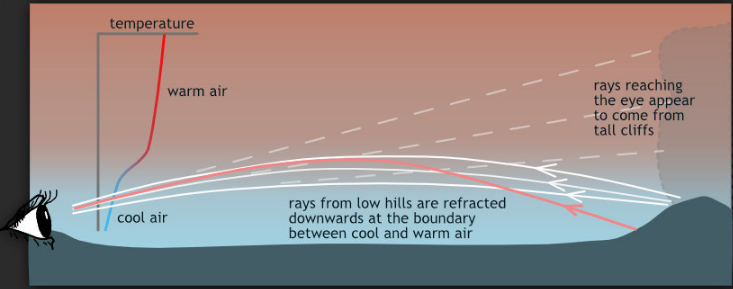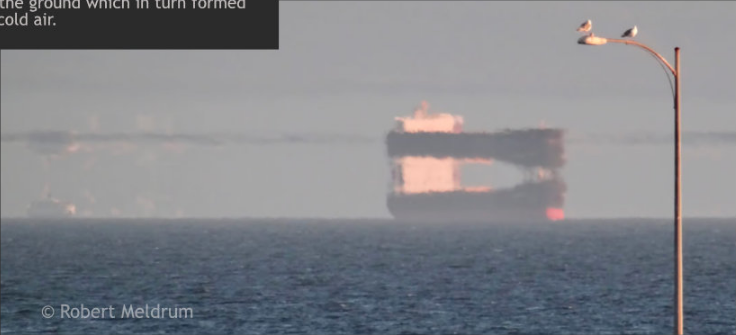Fata Morganas winter and summer
Fata Morganas: A Fascinating Mirage Phenomenon in Winter and Summer
Mirages have long captivated our imagination with their optical illusions and ethereal beauty. One particular type of mirage, known as Fata Morgana, stands out as an extreme variant of the superior mirage. Fata Morganas create mesmerizing images of inverted and upright objects stacked up over distant landscapes, such as hills, ships, or islands. In this article, we will explore the intriguing characteristics of Fata Morganas, with a focus on their appearance in both winter and summer.
The Winter Fata Morgana: Towering Cliffs and Stratification
During winter, Fata Morganas can transform the landscape into precipitous cliffs that seem to defy reality. These phantom cliffs appear taller and sharper compared to their summer counterparts. The winter mirage exhibits distinct stratification, with some parts of the image appearing inverted. Richard Holmes, the Editor of Provost News, captured a stunning winter scene in 2007 looking westwards over Provost, Alberta, Canada. Since then, these phantom cliffs have made several appearances, exclusively during the winter season.
The Summer Fata Morgana: Less Distinct Cliffs and Dispersion
Surprisingly, on July 27th, 2019, Fata Morganas made a rare summer appearance, offering a unique contrast to their more common winter occurrence. The summer cliffs, although present, appeared less distinct compared to their winter counterparts. One possible explanation for this difference lies in the stability of the lower cold air mass. It is likely that the lower cold air mass during summer was less stable and starting to disperse, resulting in a less defined mirage.
Mirage and Non-Mirage: Contrasting July's Mirage with Normal Appearance
To further understand the characteristics of Fata Morganas during summer, it is helpful to compare them with the normal appearance of the landscape. By comparing a mirage captured in July with a non-mirage image taken from the same location in late August, we can observe the differences in scale and appearance. Despite the mirage and non-mirage images having the same scale, the mirage image showcases the distorted cliffs, while the non-mirage image depicts the landscape in its usual form.
The Science Behind Fata Morganas
To comprehend the formation of Fata Morganas, we must delve into the science of atmospheric optics. Fata Morganas, like other mirages, occur due to the refraction of light as it passes from lower cool air to higher warm air. When rays of light cross this boundary, they are bent back downwards towards the cool air, leading to the formation of mirage images. In the case of Fata Morganas, a unique vertical temperature profile is required. Instead of two distinct air masses, the temperature needs to increase gradually with height, accelerate, and then increase slowly again.
Factors Influencing Fata Morgana Formation
Several factors contribute to the formation of Fata Morganas, both in winter and summer. Here are some key factors that influence their occurrence:
- Vertical temperature profile: A specific temperature gradient is necessary, with a gradual increase in temperature with height, followed by an acceleration and another gradual increase.
- Clear and still nights: Clear and calm nights allow for radiation cooling of the ground, which results in the formation of lower cold air masses. This cooling effect plays a significant role in creating the conditions for Fata Morganas.
- Atmospheric stability: The stability of the lower cold air mass impacts the clarity and sharpness of Fata Morgana images. More stable air masses tend to produce more defined mirages.
The Enigmatic Beauty of Fata Morganas
Fata Morganas have mesmerized observers for centuries with their enigmatic beauty and optical illusions. The phenomenon's name, Fata Morgana, is derived from the Arthurian sorceress Morgan le Fay, known for her ability to create illusions. These mirages have been the subject of folklore and legends, often associated with supernatural occurrences. Today, we understand the scientific principles behind Fata Morganas, but their captivating allure continues to captivate both scientists and curious onlookers.
Conclusion
Fata Morganas are a remarkable manifestation of superior mirages, renowned for their dramatic distortion of reality. Their appearance in both winter and summer offers intriguing insights into the atmospheric conditions necessary for their formation. From the towering cliffs and stratification of the winter mirage to the less distinct images observed during summer, Fata Morganas continue to mystify and inspire. By unraveling the science behind these optical phenomena, we gain a deeper appreciation for the intricate interplay of light and air in our atmosphere. So, keep your eyes open during those frosty winter days and balmy summer mornings – you never know when a Fata Morgana might grace the horizon with its elusive beauty.

Summer and Winter Fata Morganas Precipitous cliffs tower into the sky where there are only low hills. Tricks of the light, Fata Morganas. Richard Holmes, Editor of Provost News, took the winter scene in 2007 looking westwards over Provost, Alberta, Canada. Since then the phantom cliffs have appeared several times but only in winter. 27th July '19 had a surprise when they made a summer appearance. Both pictures have exactly the same scale and are merely displaced vertically.
The winter mirage is taller and sharper with some stratification. Parts are inverted. The summer cliffs are less distinct. Possibly the lower cold air mass (see below) was less stable and starting to disperse.
Below - Mirage and Non-Mirage July's mirage compared with the normal appearance in a view from the same location taken in late August. The image scales are the same.

Fata Morganas are extreme variants of superior mirages. In those, alternate inverted and upright images stack up over distant hills, ships or islands.
Both form when rays are refracted as they cross from lower cool air to higher warmer air. The rays direct back downwards towards the cool air. When rays cross (like the red ray at right) an inverted image forms.
Fata Morganas need a rather special vertical temperature profile. Instead of two distinct air masses, the temperature needs to increase slowly with height, accelerate, and then increase slowly again.
Richard Holme's summer mirage was at 8.30 in the morning. Possibly the night had been clear and still resulting in radiation cooling of the ground which in turn formed the lower cold air.


An "ordinary" superior mirage seen by Robert Meldrum.
Note: this article has been automatically converted from the old site and may not appear as intended. You can find the original article here.
Reference Atmospheric Optics
If you use any of the definitions, information, or data presented on Atmospheric Optics, please copy the link or reference below to properly credit us as the reference source. Thank you!
-
<a href="https://atoptics.co.uk/blog/fata-morganas-winter-and-summer/">Fata Morganas winter and summer </a>
-
"Fata Morganas winter and summer ". Atmospheric Optics. Accessed on December 22, 2024. https://atoptics.co.uk/blog/fata-morganas-winter-and-summer/.
-
"Fata Morganas winter and summer ". Atmospheric Optics, https://atoptics.co.uk/blog/fata-morganas-winter-and-summer/. Accessed 22 December, 2024
-
Fata Morganas winter and summer . Atmospheric Optics. Retrieved from https://atoptics.co.uk/blog/fata-morganas-winter-and-summer/.